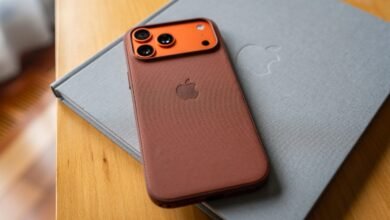Why the iPhone 17 Is This Year’s Must-Have Upgrade

▼ Summary
– The iPhone 17 now includes an always-on display and a high-refresh-rate screen, eliminating two major previous exclusions from the standard model.
– The always-on display allows users to see notifications, time, and widgets at a glance without waking the phone, enhancing convenience.
– The high-refresh-rate screen, branded as ProMotion, offers smoother animations and a more fluid user experience.
– Camera upgrades include a higher-resolution ultrawide sensor and a redesigned selfie camera with automatic framing features, though improvements are modest.
– The iPhone 17 also features double the base storage, a faster processor, and the same starting price as its predecessor, making it a strong value.
For years, opting for the standard iPhone meant accepting compromises. You weren’t just missing out on flashy extras like a telephoto lens or a more powerful chip, you were skipping features that genuinely improve daily usability. Think of the Dynamic Island, the Action Button, or a display bright enough for outdoor reading. Apple has gradually narrowed that gap, but two major omissions lingered: the always-on display and a high-refresh-rate screen. With the iPhone 17, that’s all changed.
After a week of testing, it’s clear these additions transform the experience. The phone feels faster, more responsive, and far more convenient. It’s hard to believe Apple waited this long to include what now feels essential.
The iPhone 17’s display matches the Pro model in size, resolution, and core specs. The standout upgrade is the always-on feature, which works identically to the Pro version. Set the phone down, and the screen dims to show a subtle version of your wallpaper, widgets, clock, and notifications. Everything is customizable, you can disable it, adjust blur settings, or hide the wallpaper for a minimalist black-and-white look.
Having constant access to information at a glance is incredibly practical. Notifications become easier to track, and adding a calendar widget lets you monitor upcoming events without even touching the phone. Even checking the time feels more effortless.
Battery impact is minimal. With the always-on display active, power usage stayed in the low single digits during testing, not enough to worry about during a full day of heavy use. If you prefer, you can always turn it off.
This feature is possible thanks to the new variable refresh rate display, branded as ProMotion. It drops to as low as 1Hz when idle to save power, then jumps to 120Hz when needed for smooth animations and scrolling. If you’ve never used a high-refresh-rate screen, the difference might not be instant. But after a few days, everything from app launches to browsing feels noticeably fluid. Going back becomes unthinkable.
These screen enhancements aren’t revolutionary, Android phones have had them for years, often at lower prices. But for the standard iPhone, they’re a game-changer.
Other subtle improvements include a slightly larger 6.3-inch display thanks to slimmer bezels, better scratch resistance, higher peak brightness, and a new anti-glare coating. Individually, these are minor, but together they make the screen easier to view in bright sunlight.
Camera updates are also noteworthy. The ultrawide lens now uses a 48-megapixel sensor for more detail, and the front camera includes a new sensor enabling automatic framing tricks to fit more people in the shot.
In practice, selfie quality isn’t a huge leap from the iPhone 16, but the technology behind it is smarter. The front camera uses a square sensor with 18MP resolution, allowing more flexibility in cropping and better performance in portrait orientation, how most people hold their phone for selfies.
When you open the front camera, it starts zoomed in for one person. If someone else joins, it automatically widens. Add even more people, and it switches to an ultra-wide landscape view, all while the phone stays upright. You can control this manually or let the phone handle it. For casual users, it’s a thoughtful addition.
The ultrawide camera, shared with the Pro model, offers modest improvements. Shots are slightly sharper with bolder colors, but differences are subtle. The main camera remains unchanged from last year, still a 48MP sensor, smaller than the Pro’s but capable of excellent photos. Occasionally, highlights can blow out in bright light, or motion can blur in dim settings, but the results are still pleasing.
The most significant camera difference between the standard and Pro models is zoom. The Pro includes a dedicated telephoto lens with 4x optical zoom, while the iPhone 17 offers only 2x “optical quality” zoom, essentially a crop. Images at 2x look good, but lose detail in low light. At 10x digital zoom, photos lack clarity and can appear soft. If you rarely zoom, it’s not a deal-breaker. But for those who need more reach, the Pro remains the better choice.
Beyond the screen and cameras, the iPhone 17 includes several under-the-hood upgrades. It features the new A19 chip, starts at 256GB of storage, double last year’s base, supports faster charging, and promises longer battery life. Best of all, it retains the same $829 starting price despite inflation.
Visually, the standard model doesn’t adopt the new camera bar design seen on the Pro and Air models. The sage green finish looks sharp, even if the overall design hasn’t changed much in years. If standing out matters to you, the Pro might be more appealing. But for most, the difference is negligible.
This is arguably the strongest standard iPhone release in years. For the same price, you get double the storage, better cameras, and a screen that fundamentally improves usability. Yes, the Pro still offers exclusive perks like a telephoto lens, larger sensor, and a newer design. But those are really for power users.
If you want a great iPhone without major compromises, the iPhone 17 finally delivers.
(Source: The Verge)





